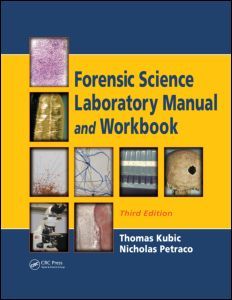Forensic Science Laboratory Manual and Workbook (3rd Ed.)
Auteur : Kubic Thomas

A laboratory companion to Forensic Science: An Introduction to Scientific and Investigative Techniques and other undergraduate texts, Forensic Science Laboratory Manual and Workbook, Third Edition provides a plethora of basic, hands-on experiments that can be completed with inexpensive and accessible instrumentation, making this an ideal workbook for non-science majors and an excellent choice for use at both the high school and college level.
This revised edition of a bestselling lab manual provides numerous experiments in odontology, anthropology, archeology, chemistry, and trace evidence. The experiments cover tests involving body fluid, soil, glass, fiber, ink, and hair. The book also presents experiments in impression evidence, such as fingerprints, bite marks, footwear, and firearms, and it features digital and traditional photography and basic microscopy.
All of the experiments incorporate practical elements to facilitate the learning process. Students must apply the scientific method of reasoning, deduction, and problem-solving in order to complete the experiments successfully and attain a solid understanding of fundamental forensic science. Each of the 39 chapters features a separate experiment and includes teaching goals, offers the requisite background knowledge needed to conduct the experiments, and lists the required equipment and supplies. The book is designed for a cooperative learning setting in which three to five students comprise a group. Using the hands-on learning techniques provided in this manual, students will master the practical application of their theoretical knowledge of forensics.
Date de parution : 04-2009
21x28 cm
Date de parution : 07-2018
21x28 cm
Thèmes de Forensic Science Laboratory Manual and Workbook :
Mots-clés :
Forensic Odontology; Bloodstain Patterns; Footwear Impressions; Friction Ridges; Firing Pin Impressions; Ocular Micrometer; Forensic Anthropologists; Latent Fingerprint; Cartridge Case; Crime Scene; Stage Micrometer; Firing Pin; Bite Mark; Footwear Evidence; Ocular Scale; Exposure Time; Dental Stone Cast; Hair Specimen; Tool Mark Examination; Artificial Blood; Sample Preparation; Smokeless Powder; Trace Evidence; Silicone Casting Material; Gas Chromatograph
